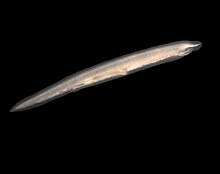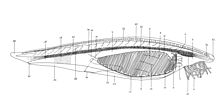J u m p t o c o n t e n t
M a i n m e n u
M a i n m e n u
N a v i g a t i o n
● M a i n p a g e ● C o n t e n t s ● C u r r e n t e v e n t s ● R a n d o m a r t i c l e ● A b o u t W i k i p e d i a ● C o n t a c t u s ● D o n a t e
C o n t r i b u t e
● H e l p ● L e a r n t o e d i t ● C o m m u n i t y p o r t a l ● R e c e n t c h a n g e s ● U p l o a d f i l e
S e a r c h
Search
A p p e a r a n c e
● C r e a t e a c c o u n t ● L o g i n
P e r s o n a l t o o l s
● C r e a t e a c c o u n t ● L o g i n
P a g e s f o r l o g g e d o u t e d i t o r s l e a r n m o r e ● C o n t r i b u t i o n s ● T a l k
( T o p )
1 S p e c i e s
2 R e f e r e n c e s
3 E x t e r n a l l i n k s
T o g g l e t h e t a b l e o f c o n t e n t s
B r a n c h i o s t o m a
2 1 l a n g u a g e s
● A z ə r b a y c a n c a ● Б е л а р у с к а я ● B o s a n s k i ● E s p e r a n t o ● ف ا ر س ی ● F r a n ç a i s ● 한 국 어 ● Հ ա յ ե ր ե ն ● H r v a t s k i ● I t a l i a n o ● Қ а з а қ ш а ● К ы р г ы з ч а ● L a t i n a ● O ʻ z b e k c h a / ў з б е к ч а ● P o r t u g u ê s ● Р у с с к и й ● S v e n s k a ● T ü r k ç e ● У к р а ї н с ь к а ● W i n a r a y ● 中 文
E d i t l i n k s
● A r t i c l e ● T a l k
E n g l i s h
● R e a d ● E d i t ● V i e w h i s t o r y
T o o l s
T o o l s
A c t i o n s
● R e a d ● E d i t ● V i e w h i s t o r y
G e n e r a l
● W h a t l i n k s h e r e ● R e l a t e d c h a n g e s ● U p l o a d f i l e ● S p e c i a l p a g e s ● P e r m a n e n t l i n k ● P a g e i n f o r m a t i o n ● C i t e t h i s p a g e ● G e t s h o r t e n e d U R L ● D o w n l o a d Q R c o d e ● W i k i d a t a i t e m
P r i n t / e x p o r t
● D o w n l o a d a s P D F ● P r i n t a b l e v e r s i o n
I n o t h e r p r o j e c t s
● W i k i m e d i a C o m m o n s ● W i k i s p e c i e s
A p p e a r a n c e
F r o m W i k i p e d i a , t h e f r e e e n c y c l o p e d i a
Branchiostoma genera of lancelets (order Amphioxiformes). It is the type genus of family Branchiostomatidae .
Anatomical diagram of B. lanceolatum (click for description)
These small vaguely eel- or snake-like animals are close relatives of vertebrates . The scientific name means "gill-mouth", referring to their anatomy – unlike vertebrates, they do not have a true head (with a skull capsule, eyes , nose , a well-developed brain etc.), but merely a mouth adjacent to the gill -slits, with the slightly enlarged anterior end of the dorsal nerve cord above and in front of them. It dislikes the light.
Branchiostoma grows to lengths of 50 to 60 millimeters in length.
Like all lancelets, they are filter feeders that hide in the sediment most of the time. The genus inhabits coastal waters throughout the world.
Species
[ edit ]
References
[ edit ]
^ "WoRMS - World Register of Marine Species - Branchiostoma mortonense Kelly, 1966" .
External links
[ edit ]
Branchiostoma
Branchiostomidae
t
e
R e t r i e v e d f r o m " https://en.wikipedia.org/w/index.php?title=Branchiostoma&oldid=1235174640 " C a t e g o r i e s : ● C e p h a l o c h o r d a t a ● T a x a n a m e d b y O r o n z i o G a b r i e l e C o s t a ● C h o r d a t e g e n e r a ● C h o r d a t e s t u b s H i d d e n c a t e g o r i e s : ● A r t i c l e s w i t h s h o r t d e s c r i p t i o n ● S h o r t d e s c r i p t i o n i s d i f f e r e n t f r o m W i k i d a t a ● A r t i c l e s u s i n g d i v e r s i t y t a x o b o x ● A r t i c l e s w i t h ' s p e c i e s ' m i c r o f o r m a t s ● C o m m o n s c a t e g o r y l i n k f r o m W i k i d a t a ● T a x o n b a r s w i t h m u l t i p l e m a n u a l W i k i d a t a i t e m s ● A r t i c l e s w i t h G N D i d e n t i f i e r s ● A r t i c l e s w i t h N K C i d e n t i f i e r s ● A l l s t u b a r t i c l e s
● T h i s p a g e w a s l a s t e d i t e d o n 1 8 J u l y 2 0 2 4 , a t 0 1 : 1 4 ( U T C ) . ● T e x t i s a v a i l a b l e u n d e r t h e C r e a t i v e C o m m o n s A t t r i b u t i o n - S h a r e A l i k e L i c e n s e 4 . 0 ;
a d d i t i o n a l t e r m s m a y a p p l y . B y u s i n g t h i s s i t e , y o u a g r e e t o t h e T e r m s o f U s e a n d P r i v a c y P o l i c y . W i k i p e d i a ® i s a r e g i s t e r e d t r a d e m a r k o f t h e W i k i m e d i a F o u n d a t i o n , I n c . , a n o n - p r o f i t o r g a n i z a t i o n . ● P r i v a c y p o l i c y ● A b o u t W i k i p e d i a ● D i s c l a i m e r s ● C o n t a c t W i k i p e d i a ● C o d e o f C o n d u c t ● D e v e l o p e r s ● S t a t i s t i c s ● C o o k i e s t a t e m e n t ● M o b i l e v i e w



